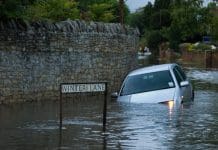After a year of wild weather around the world and with Britain facing the threat of more extreme storms, Anthony Guay of Ramboll UK looks at what we can learn from international approaches to flood protection
2017 has been a year of extreme storms, from Texas and Florida to the Caribbean; these disasters offer clear reminder of the impacts of climate change. In 2016, Houston was deluged by a 45cm rainfall in one day, while this August, Hurricane Harvey poured over 120cm of rain in five days. By comparison, the UK average for annual rainfall is 90cm. At least 77 lives were lost as a result of Hurricane Harvey and estimates at the financial cost place it as high as $100bn (£77bn). Much of the affected area in Houston was considered at risk of flooding but was developed upon due to the ever-increasing pressures of urban expansion.
The UK is also witnessing more extreme weather. The temperate summer of 2017 saw flooding in Cornwall, as well as flood warnings issued in London and Yorkshire in early August.
Intense rainfall overwhelms our cities’ drainage and the clean-up is extremely costly. Extreme flooding will become more common this century, according to the Intergovernmental Panel on Climate Change. We’re faced with the challenge of improving our national infrastructure’s resilience. However, new responses to such events are being developed around the world, offering pointers for the UK.
Looking for lessons abroad
In Singapore, fluctuating water levels made planners reconsider one of the city’s main drainage canals, transforming it into a natural winding river embedded in parkland. Bishan Park, its new name, can handle the intense rainfall that Singapore receives while remaining traversable and pleasant for citizens.
Stateside, Portland’s archaic sewerage systems led the city to implement blue-green infrastructure to help mitigate flooding issues. Schemes such as ‘eco-roofs’ will improve water absorption. These vegetated roofing systems also double as wildlife habitats. Similarly, green streets pair standard drainage with greenery. More widely, some 40,000 new trees will aid water retention across the city, as well as helping to improve air quality.
Possibly the most salient lesson comes from Denmark. In 2011, Copenhagen received 150mm of rainfall in just two hours; some neighbourhoods were left under a metre of water. The Danish call these events “cloudbursts”, a term suited to such extreme storms. The rain caused insurance claims totalling more than €800m and overall socio-economic losses are thought to have doubled this amount. The city responded with a “cloudburst mitigation plan”. With input from Ramboll, among others, they determined the city’s most at-risk areas, proposing a toolkit of solutions, including:
- Green streets like Portland’s, with road profiles and cambers adapted for surface level water storage and conveyance, maintaining a ‘dry lane’ for travel.
- The central St Jorgen’s Lake would have its water level lowered to provide storage during flooding, in addition to city squares being adapted to store flood water.
In all cases, the goal is to ally water management with attractive public spaces. Such parks and areas can be scenic, reverting to floodplains and controlled storage areas in moments of acute necessity.
Domestic concerns
But can such measures be applied in the UK? Maybe more easily than we think. In Yorkshire’s Calderdale, Ramboll and the local council have worked together on the possible implementation of ‘toolkit’ techniques.
Sustainable drainage systems (SuDS) are also becoming more mainstream, although uptake has been delayed by slow implementation of the 2010 Flood & Water Management Act. Regardless, SuDS are now an essential consideration for major planning applications.
For in excess of 20 years, many Ramboll projects in the UK have embraced SuDS, featuring permeable paving, swales and surface water features, to welcome and encourage wildlife while reducing flooding.
A greater challenge lies in finding willingness to integrate catchment solutions, like in Copenhagen. Surface water management plans undertaken by lead local flood authorities have gone partway to creating a more complete approach, but their actual efficacy is dubious – especially with the recent trend of reductions in government spending and council budgets.
Despite this, there are cases of effective, proactive measures in the UK. In the heart of London, the Queen Caroline Estate has been remodelled to feature green roofs on bin stores, as well as rain gardens and detention basins with raised walkways. These additions are attractive for local residents compared with asphalt spaces and concrete materials, and have proven hugely popular.
Looking ahead
These projects, in light of the international picture, show that the toolkit approach showcased by Copenhagen is potent. There are a variety of tools available to planners, including:
- Rain gardens.
- Green streets.
- Permeable paving.
- Urban tree planting.
- Living, green or blue roofs.
- Swales.
With bureaucratic cooperation, these techniques should be hugely effective in fighting UK flooding. The costs of doing nothing are mounting, and our cities should learn from good practice and innovative approaches to be found within the UK and abroad.
Flood risk can be mitigated by an approach combining canny landscaping, sensible planning and innovative engineering to combat the global impacts of climate change. After the 2017 extreme storms in India, Bangladesh, the Caribbean and America, it will be interesting to see if world leaders act on this threat.
Anthony Guay
Director
Ramboll UK
Tel: +44 7918 768716
Twitter: @ramboll_uk

















